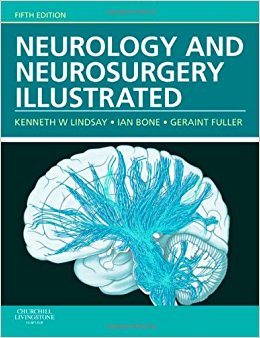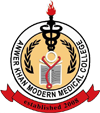Anwer Khan Modern Medical College
Library Management System

| Title: | Neurology and neurosurgery illustrated |
| Author Name: | Kenneth W. Lindsay...[et al]. |
| Author Sur Name: | LINDSAY, Kenneth W. |
| Other's Author Name: | Ian Bone, Geraint Fuller, Robin Callander and J. Van Gijn. |
| Author information: |
|
| Edition/Published: | 5th ed. _New York : Elsevier , 2012 |
| New to this edition: |
|
|
Physical Description: x, 600p., : <p>ill., tables</p>.; 24cm. |
| Notes | Includes Bibliographical References and Indexes |
| Bibliography: | P. 565 |
| Includes Index: | P. 567-600 |
| ISBN No's: | 978-0-443-06978-9 |
| Bar Code's: | |
| Shelf Location's: | 22 |
| Classification | |
| Subject: | Nervous System--Surgery |
| Dewey Class No: | 617.48 |
| Letter Call No: | L64n |
| LC Classification: | RD593 .L56 2010 |
| Other's Book Information | |
| Book ID No: | 1781 |
| Total Books: | 1 |
| Date of collection's: | 01-Nov-2016 |
| Donation / Purchase: | Purchase |
| Language: | English |
| Status: | Available |
| Department: | Neurology and Neurosurgery |
| Synopsis: |
|
| Review: |
|
| Description: |
|
| Key Features: |
|
| Summary: |
This is the new edition of a highly successful illustrated guide to neurology and neurosurgery for medical students and junior doctors. New edition of a highly successful illustrated guide to neurology and neurosurgery for medical students and junior doctors. Updated and revised in all areas where there have been developments in understanding of neurological disease and in neurological and neurosurgical management. This revision has also incorporated current guidelines, particularly recommendations from National Institute for Health and Clinical Excellence (NICE). |
| Abstract: |
The fifth edition of Neurology and Neurosurgery Illustrated has been updated and revised throughout, particularly where there have been development in the understanding of the pathogenesis of neurological disease and in neurological and neurosurgical management of patients. It has incorporated current clinical guidelines, including recommendations from the UK National Institute for Health and Clinical Excellence (NICE). Neurology and Neurosurgery Illustrated is ideal for medical students and junior doctors. The concise text is arranged around clear and memorable illustrations, which helps to clarify subject areas that most students tend to find difficult and forbidding. The simplicity and clarity of its diagrams convey information in a more memorable fashion than any competitor text. |
| Preface: |
It has been 24 years since the rst edition of Neurology and Neurosurgery Illustrated was published. On writing each new edition, we are always surprised at the number of changes required. For this edition there is an additional change. Ian Bone has retired from clinical practice and Geraint Fuller has joined to edit and update this edition. As in all previous editions there have been updates in many areas. With the increasing trend to sub-specialise within clinical neuroscience, we have become increasingly dependent on colleagues for advice. The following have provided many valuable suggestions – Laurence Dunn, Patricia Littlechild and Jerome St George (neurosurgery), Colin Smith (neuropathology), Alison Wagsta (neuroanaesthetics), Donald Hadley (neuroradiology) and Roy Rampling (oncology). We would like to oer sincere thanks to all. Finally we are indebted to Ailsa Laing of Elsevier for her patience and gentle encouragement. 2010 K.W. Lindsay, I. Bone, G. Fuller |
| Content: |
Front Matter Copyright FOREWORD PREFACE SECTION I General approach to history and examination-1-32 Nervous system - history-2 Nervous system - examination-4 Examination - conscious level assessment-5 Examination - higher cerebral function-7 Cranial nerve examination-9 Examination - upper limbs-18 Examination - trunk-24 Examination - lower limbs-24 Examination - posture and gait-28 Examination of the unconscious patient-29 The neurological observation chart-31 SECTION II Investigations of the central and peripheral nervous systems-33 Skull X-ray-34 Computerized tomography (CT) scanning-35 Magnetic resonance imaging (MRI)-39 Ultrasound-44 Angiography-45 Radionuclide imaging-48 Electroencephalography (EEG)-51 Intracranial pressure monitoring-52 Evoked potentials - visual, auditory and somatosensory-54 Evoked potentials - somatosensory-55 Lumber puncture (LP)-56 Cerebrospinal fluid-57 Electromyography/nerve conduction studies-58 Neuro-otological tests-62 SECTION II Clinical presentation, anatomical concepts and diagnostic approach-67 Headache - general principles-68 Headache - diagnostic approach-69 Headache-special causes-70-74 Meningism-75 Raised intracranial pressure-76 Coma and impaired conscious level-85 Transient loss of consciousness-90 Confusional states and delirium-91 Epilepsy-92 Seizure classification-93 The partial seizures-94 Partial seizures evolving to tonic/clonic convulsion-96 Generalized seizures-97 Symptomatic seizures-98 Seizures - differential diagnosis-99 Epilepsy-classification-100 Epilepsy-investigation-101 Epilepsy-treatment-102 Epilepsy-surgical treatment-103 Epilepsy-specific issues-104 Status epilepticus-105 Disorders of sleep-106 Higher cortical dysfunction-109 Frontal lobes-111 Parietal lobes-112 Temporal lobes-114 Occipital lobe-115 Apraxia-116 Higher cortical dysfunction-disconnection syndromes-117 Higher cortical function-memory-118 Disorders of memory-119 Disorders of speech and language-120 Disorders of speech-dysarthria-121 Disorders of speech – dysphonia-122 Disorders of speech – dysphasia-123 Dementias-125 Dementias – classification-126 Dementias – history and clinical examination-127 Dementias – specific diseases-128 Dementia – diagnostic approach-132 Impairment of vision-133 Disorders of smell-141 Pupillary disorders-142 Diplopia – impaired ocular movement 147–154 Disorders of gaze-155 Facial pain and sensory loss-158 Facial pain – diagnostic approach-162 Facial pain – trigeminal neuralgia-163 Facial pain – other causes-165 Facial weakness-166 Bell’s palsy-170 Other facial nerve disorders 171 Deafness, tinnitus and vertigo-172 Disorders of the lower cranial- nerves-175 Causes of lower cranial nerve palsies-179 Cerebellar dysfunction-180 Symptoms and signs of cerebellar dysfunction-182–183 Classification of cerebellar dysfunction-183 Nystagmus-184 Tremor-188 Myoclonus-190 Disorders of stance and gait-191 Specific disorders of stance and gait-192 Limb weakness-193 Sensory impairment-199 Pain-204 Pain – treatment-206 Pain syndromes-208 Limb pain 210 Muscle pain (myalgia) 212 Outcome after brain damage-214 Brain death-215 Disorders of speech – dysphonia 122 Disorders of speech – dysphasia 123–124 Dementias 125 Dementias – classification 126 Dementias – history and clinical examination 127 Dementias – specific diseases 128–131 Dementia – diagnostic approach 132 Impairment of vision 133–140 Disorders of smell 141 Pupillary disorders 142–146 Diplopia – impaired ocular
movement 147–154 Disorders of gaze 155–157 Facial pain and sensory loss 158–161 Facial pain – diagnostic approach 162 Facial pain – trigeminal
neuralgia 163–164 Facial pain – other causes 165 Facial weakness 166–169 Bell’s palsy 170 Other facial nerve disorders 171 Deafness, tinnitus and vertigo 172–174 Disorders of the lower cranial
nerves 175–178 Causes of lower cranial nerve
palsies 179 Cerebellar dysfunction 180–181 Symptoms and signs of
cerebellar dysfunction 182–183 Classification of cerebellar
dysfunction 183 Nystagmus 184–187 Tremor 188–189 Myoclonus 190 Disorders of stance and gait 191 Specific disorders of stance
and gait 192 Limb weakness 193–198 Sensory impairment 199–203 Pain 204–205 Pain – treatment 206–207 Pain syndromes 208–209 Limb pain 210–211 Muscle pain (myalgia) 212–213
Outcome after brain damage 214 Brain death 215–216
SECTION IV Localised neurological disease and itsmanagement-217 A. Intracranial Head injury 218–220 Head injury – clinical assessment-221 Head injury – investigation and referral criteria-226 Head injury – investigation-228 Head injury – management-230 Depressed skull fracture-234 Delayed effects of head injury-235 Chronic subdural haematoma-239 Cerebrovascular diseases-241 Cerebrovascular disease– mechanisms-242 Cerebrovascular disease– natural history-242 Cerebrovascular disease – causes-243 Occlusive and stenotic cerebrovascular disease-244 Cerebrovascular disease – pathophysiology- 245–246 Transient ischaemic attacks (TIAs)-247 Clinical syndromes – large vessel occlusion-248 Clinical syndromes – branch occlusion-254 Clinical syndromes – lacunar stroke (LACI)57 Classification of subtypes of cerebral infarction-258 Embolisation 258 Stenotic/occlusive disease – investigations 260 Cerebral infarction – management-262 TIAs and minor infarction– management-264 Hypertension and cerebrovascular disease 265 tahir99-VRG & vip.persianss.ir
CONTENTS
Chapter 3: CLINICAL PRESENTATION, ANATOMICAL CONCEPTS AND DIAGNOSTIC APPROACH Chapter 4: LOCALISED NEUROLOGICAL DISEASE AND ITS MANAGEMENT A. INTRACRANIAL Chapter 5: LOCALISED NEUROLOGICAL DISEASE AND ITS MANAGEMENT B. SPINAL CORD AND ROOTS Chapter 6: LOCALISED NEUROLOGICAL DISEASE AND ITS MANAGEMENT C. PERIPHERAL NERVE AND MUSCLE Chapter 7: MULTIFOCAL NEUROLOGICAL DISEASE AND ITS MANAGEMENT FURTHER READING INDEX |
